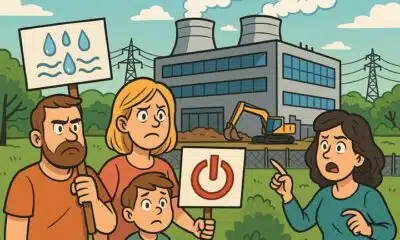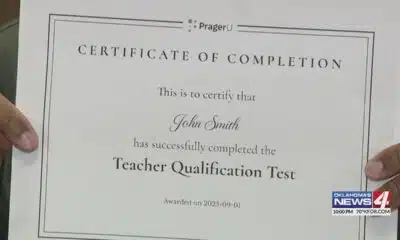News from the South - Louisiana News Feed
Red Alert: A refinery spilled toxic waste into the community and knew about it for months
by Wesley Muller, Louisiana Illuminator
June 2, 2025
GRAMERCY — For several months, a River Parishes refinery unlawfully discharged industrial toxic waste containing arsenic, cadmium, chromium and other toxic heavy metals into public areas and waterways, state records show.
The company, Atlantic Alumina, also known as Atalco, has so far racked up 23 violation notices from the Louisiana Department of Environmental Quality after inspectors first discovered the pollution in August. It involves a slurry of industrial “red mud” byproduct that has eroded through the giant levees surrounding the facility’s waste containment lakes and spilled onto public property. The toxic sludge has killed vegetation and contaminated the land along its path to a local drainage system that flows to the Blind River Swamp of Lake Maurepas, according to a 606-page LDEQ inspection report finalized in March.
The incident marks the first known case of red mud levee breaches at an American bauxite refinery. When asked for details, LDEQ spokesman Gregory Langley had little information to share about the prolonged discharge other than to say it is currently under investigation with the agency’s enforcement division. The only enforcement action taken as of May 29 is a warning letter LDEQ sent to Atalco.
A review of thousands of pages of state and federal documents and interviews with scientists and area residents indicate that Atalco polluted public land and state waterways with the most toxic non-radioactive elements on the planet and allowed that pollution to continue for months — never notifying the outside community.
Atalco’s refinery occupies roughly 3 square miles of land where St. James and St. John the Baptist parishes meet on the Mississippi River’s east bank. The site specializes in refining bauxite, a rust-colored powder of raw metals and minerals, into aluminum oxide or “alumina” in the form of an ultra-fine white powder. Atalco sells the alumina to metal smelters that need it to make finished aluminum. Opened in 1958 as Kaiser Aluminum, the Gramercy facility is the only remaining bauxite refinery in the United States and therefore the nation’s only domestic source of a critical metal feedstock.
Atalco produced 669,261 metric tons of aluminum oxide last year, state records show. For every ton of aluminum produced from Atalco’s work, bauxite refining generates an estimated 2.5 tons of waste byproduct, according to the U.S. Environmental Protection Agency.
One of the main problems in refining bauxite is there are not many good options for what to do with all that waste, most of which takes the form of a thick red mud.
The waste comes from a part of the process in which bauxite is heated in a pressurized vessel with sodium hydroxide, a highly caustic chemical. The alumina compounds are then filtered out and separated, while the toxic byproduct is stored in the facility’s six red mud lakes. The lakes are open-air ponds, each roughly 150-200 acres in size surrounded by large earthen levees, some as high as 50 feet, meant to contain the thick liquid waste.
Four of the lakes, including a “surge” or overflow basin, were constructed in the early 1970s without any liners that would help prevent the heavy metals and chemicals from seeping into the soil below.
“It is very dangerous,” said Slawomir Lomnicki, an environmental scientist at LSU. “There can be a lot of toxic metals leaching out of it and getting into the groundwater.”
Groundwater contamination from leaching is a constant risk that exists when Atalco’s systems are operating normally. The public drinking water system in St. James Parish regularly monitors for that kind of contamination, according to Parish President Peter Dufresne. Officials with the St. John Parish water system did not answer multiple phone calls last week.
A greater risk to the community from bauxite refineries in general is the rare case of a levee breach at a red mud lake, which can cause toxic waste to directly contaminate public waters and soils, scientists said.
Until this reporting, the last known breach at a bauxite refinery occurred in Hungary in 2010. The failure of a red mud reservoir sent 35 million cubic feet of waste into nearby villages, killing 10 people and injuring 150 others.
In the wake of that incident, industry officials told the American public that a levee breach at Louisiana’s bauxite refinery would be unlikely because the levees are “periodically checked by state and federal regulators,” according to a news report from that time.
That unlikely event has happened at Atalco. With a caustic level higher than drain cleaner and elevated concentrations of heavy metals, Atalco’s waste slurry eroded through levees in multiple locations at multiple lakes, forming canyons as deep as 10 feet that allowed the toxic waste to escape, records show.
A water sample LDEQ had tested from a public ditch outside the plant detected arsenic at a concentration nearly 1,400% higher than the level considered safe by state groundwater and EPA drinking water limits. The sample also contained cadmium at levels above those same limits.
A soil sample taken from the same ditch contained mercury, beryllium, cadmium and chromium — all at concentrations above the average background levels found in U.S. soils. The cadmium was nearly 400% higher, and the chromium was 900% higher than LDEQ’s standard limits for soil. Chromium is the most toxic non-radioactive element on earth and is about three times more poisonous than arsenic, according to EPA toxicity factors.
Historic water quality data for the Blind River, recorded from 1979-99, show heavy metal concentrations nowhere near those levels.
When the levees broke
“With this kind of facility, the worst major accident that can happen is a breach of the lake [levees],” said Corinne Gibb, a chemist who works with the environmental watchdog Louisiana Bucket Brigade. The group has monitored incidents at the alumina refinery for years.
It is unknown when the mud lake levees first began to erode, but state and federal records show the pollution lasted for months and continued even after Atalco became aware of the problem.
The company has not responded to the Illuminator’s multiple requests for an interview.
Federal inspectors with the Mine Safety and Health Administration (MSHA) documented several hazards at Atalco’s levees last summer and voiced concerns about the risks they posed to the workers at the plant.
“There were several mud lakes at the facility that was (sic) not being maintained,” MSHA inspector Brandon Olivier wrote in a citation dated June 25, 2024.
Trees and shrubs obscured sections of the levees, making thorough inspections impossible, Olivier added.
A few weeks later, on Aug. 14, the MSHA issued Atalco another citation after inspectors discovered caustic waste “seeping through various locations on the east and west side of Mud Lake #4” and flowing downhill “into the roadway and ditches.”
LDEQ later noted the Aug. 14 citation was the first formal written notice Atalco received about the levees having a breach with dangerous toxic waste escaping from its facility.
Other dangers present at the Atalco plant had already drawn regulators’ attention at that time.
Just days prior, on Aug. 4, the public was reminded just how dangerous the chemicals at Atalco could be when 45-year-old Curtis Diggs, a contract worker from Waste-Pro USA, fell into a pit of sodium hydroxide at the plant because a grate that covered the pit was missing and the entire floor was flooded with several inches of the caustic cloudy liquid. The chemical, the same that is stored in the red mud lakes, left Diggs with severe burns from which he did not recover, according to LDEQ records. He died in a New Orleans hospital on Sept 2.
MSHA investigated the fatality and learned that Atalco personnel had removed the grate on July 30, 2024, to try to pump out the flooded area and failed to put anything in its place or even a warning marker, creating a dangerous pitfall left open for five days and virtually invisible. MSHA charged Atalco with three regulatory violations and charged Waste-Pro USA with two, faulting both companies for “aggravated conduct” that involved an extraordinary pattern of negligence, though it’s unclear if any fines or penalties have been issued as of May 30, according to federal records.
Atalco uses sodium hydroxide to refine bauxite into alumina. After the refinement process, it stores the used sodium hydroxide in the lakes with the other waste.
Despite the heightened scrutiny from state and federal regulators at the time, by mid-September Atalco still had not repaired the levee breaches to Red Mud Lake 4 that federal inspectors cited the month before. Nor did the company thoroughly inspect its other lakes to look for similar breaches because, as the records indicate, similar breaches were there — if only the company had looked.
On Sept. 17, MSHA inspectors found a breach in the levee around another lake, Red Mud Lake 1 East, with a stream of hazardous waste flowing freely across the roadway.
“The caustic was observed seeping through the side of the levee for approximately 50 yards across the roadway and to the ditch,” the citation states. “The mud lake is access[ed] by the plant operators daily and contractors for service, and this condition exposes them to injuries if there is a dam failure due to the seepage.”
Based on further inspections that same day, MSHA cited Atalco for a third levee break — at Red Mud Lake 2.
On that single day, three of Atalco’s six waste lakes had confirmed breaches with streams of poisonous chemicals flowing freely to areas they weren’t permitted to go, including the Blind River Swamp — a popular recreational fishing spot in the Lake Maurepas backwaters.
LDEQ officials first arrived at the plant Sept. 20 to initiate a routine compliance inspection. Agency records show state officials met with Atalco managers, conducted an interview and toured parts of the facility. However, they were unable to inspect some of the lakes and levees because the plant manager told them the access roads were too wet to travel on.
LDEQ first documented the levee breaches five days later when they were contacted by the federal inspectors, according to state records. Atalco had still not officially notified LDEQ of the levee breaches — something the company should have done immediately upon learning of them in accordance with Atalco’s permit requirements as well as state and federal laws.
Local officials have also been kept in the dark. When asked about the events during an impromptu meeting with a reporter Thursday at the State Capitol, St. James Parish President Peter Dufresne said he was unaware of Atalco’s levee breaks that contaminated neighboring land and drainage with toxic waste. Dufresne declined an interview but asked the Illuminator for copies of LDEQ’s inspection reports.
In October, the records show, state inspectors discovered erosion channels in the levee of a fourth lake, Red Mud Lake 3. They also saw for themselves the levee breaches that federal inspectors documented two months before. The erosion channels were still there, and the caustic waste was still escaping from those lakes.
So much waste had escaped that it also overwhelmed the facility’s secondary containment system, which is a network of interior ditches just outside of the levees used to catch any chemical spills or leaks from the lakes. The backup ditch at one location had overflowed, sending the toxic slurry across the highway just north of the Veterans Memorial Bridge.
Atalco was also, as a matter of protocol, unlawfully using a stormwater ditch as a backup containment ditch. Three company officials, apparently unaware that they weren’t permitted to use the ditch for toxic waste disposal, told LDEQ inspectors that they routinely used it for containment, according to the inspection files.
In other areas, LDEQ inspectors saw that the waste slurry had accumulated to “nearly the height of the levee” in some of the lakes, the agency’s files note. The waste level in the lakes should never be allowed to rise higher than two feet from the top of the levee.
Ultimately, in site visits over the next three months, LDEQ inspectors viewed and documented levee breaches at four of Atalco’s six lakes, prompting the state agency to cite Atalco multiple times for failing to inspect and failing to repair the levees.
Erosion of the levees was a very real possibility that Atalco had long known about. In its 2010 permit renewal applications with the state, the company had addressed the topic at length, promising to prevent erosion by conducting daily inspections of the levees and keeping written logs of those inspections. The state included those as specific ongoing requirements in the final permit issued to Atalco. At that time, the company was in the process of raising its levees from 30 feet to 50 feet high, according to the permit application.
By the time state and federal officials began prodding the company last August, Atalco had not consistently inspected its lakes and levees in over three years and was missing hundreds of daily inspection records from July 30, 2021, to Dec. 18, 2024, according to LDEQ’s summary of violations.
On Oct. 23, state officials noted the company was constructing a new berm to contain the breach at Red Mud Lake 4, which Atalco had known about since at least Aug. 14.
The breach at Red Mud Lake 3 continued until Dec. 4, according to the LDEQ file. On that day, Atalco managers accompanied state inspectors into the field when they noticed multiple streams emerging near an access road and traced it back to “one erosion channel with an estimated depth of at least 10 feet.”
The chemistry of Atalco’s toxic waste
During their site visits in October, the state inspectors took pH readings from various pools of standing waste that had escaped from the lakes
The pH scale ranges from 0 to 14, with water having a neutral pH of around 7. Lower values indicate acidity, while higher values indicate alkalinity. Substances at the extreme ends of the scale in either direction can eat through solid materials such as steel and concrete and are very dangerous to most life forms.
The LDEQ detected high pH at every location, with one puddle logged at a high of 12.49 — the same alkalinity as most caustic drain clog removers and ammonia-based cleaners. The inspectors also photographed dead or dying vegetation, petrochemical sheens, and white and yellow chemical residues in many of the locations where the slurry had traveled.
“Just the pH by itself is concerning … That is very high,” Gibb, the chemist, said. “You would definitely get injuries and skin burns from it. The plants and any fish in the area would die from that. You can’t survive that high of a pH.”
State inspectors had testing done on water and soil samples from off-site locations in the public drainage system and on-site locations near the erosion streams. Simultaneously, Atalco personnel collected their own batch of samples and sent them to a separate lab for independent testing.
LDEQ’s soil samples contained significantly elevated levels of cadmium, chromium and nickel — all toxic carcinogens. Atalco’s samples reaffirmed the LDEQ’s lab results and detected even higher levels at one location. The company’s sample taken from public property outside the facility contained cadmium at roughly 1,000% higher than what the state considers safe for people. Additionally, the levels of chromium and nickel measured 1,700% and 300% above their respective state standards, the lab reports show.
Gibb and Lomnicki, the LSU scientist, said these three heavy metals, along with arsenic, are among the most dangerous non-radioactive substances on the planet. Exposure to excessive levels can cause a range of serious health issues, including cancer and blood poisoning.
Ganga Hettiarachchi, a Kansas State University professor of soil and environmental chemistry, said cadmium could pose the greatest long-term risk because it spreads easily and accumulates in living organisms over time. Enough small doses during a given time period can add up to a fatal dose, she said.
Cadmium is highly toxic to humans in short- and long-term exposure settings. Small concentrations ingested or inhaled can cause gastrointestinal or respiratory illness, while higher concentrations can cause cancer, cell death, neurological damage and organ system failure, according to the National Institutes of Health.
Increasing the risk from cadmium is that it can be easily spread across far distances and transfer from soil into crops, Hettiarachchi said, posing risks to humans and animals if they eat those crops.
“It could easily end up in our food,” she said. “That has been historically the main pathway for cadmium.”
If cadmium gets into surface water or groundwater, it can become an even bigger problem, especially if that water is used for irrigation, she added.
“The area of damage can expand further and further over time,” Hettiarachchi said.
Cadmium was present at elevated levels in two of Atalco’s water samples and four of LDEQ’s. The highest concentration was 400% above the level considered safe in a water sample taken from an erosion channel within the perimeter of the facility. It also had high levels of chromium and lead.
All seven water samples that LDEQ had tested contained elevated levels of arsenic. One of them taken from outside the levee of a red mud lake detected arsenic at a level 9,000% higher than state and federal safe limits, and it contained high levels of cadmium, nickel and thallium. Six out of the seven samples Atalco personnel collected contained arsenic at levels beyond what is considered safe.
LDEQ has yet to address the risks Atalco’s red mud runoff could pose to the community. Langley, the agency’s spokesman, said it has yet to determine what the public impact might be.
“Obviously those are things we don’t want going into state waterways,” Langley said.
Part Two: For some nearby residents, the levee breaches at Atalco are just the latest incident in a familiar pattern. The second story in this series reveals why the incident at Atalco was foreseeable based on the history of the plant and the many accidents and environmental exposures to the nearby communities.
“They’re turning a blind eye to it,” said Gail LeBouef, who’s lived near the plant since 1999.
YOU MAKE OUR WORK POSSIBLE.
Louisiana Illuminator is part of States Newsroom, a nonprofit news network supported by grants and a coalition of donors as a 501c(3) public charity. Louisiana Illuminator maintains editorial independence. Contact Editor Greg LaRose for questions: info@lailluminator.com.
The post Red Alert: A refinery spilled toxic waste into the community and knew about it for months appeared first on lailluminator.com
Note: The following A.I. based commentary is not part of the original article, reproduced above, but is offered in the hopes that it will promote greater media literacy and critical thinking, by making any potential bias more visible to the reader –Staff Editor.
Political Bias Rating: Center-Left
This article presents detailed investigative reporting focusing on environmental violations by a corporation, emphasizing the risks posed to public health and the apparent regulatory shortcomings. The tone is critical of corporate negligence and government enforcement delays, which aligns with a center-left perspective that often advocates for stronger environmental protections and corporate accountability. The coverage highlights the impact on local communities and environmental justice concerns without overt partisan framing, maintaining factual detail but with a clear focus on holding industry and regulators accountable for environmental harm.
News from the South - Louisiana News Feed
Lafayette prosecutor Gary Haynes’ federal bribery trial starts
SUMMARY: Gary Haynes, longtime Lafayette Assistant District Attorney, faces federal trial Monday on bribery, kickback, money laundering, and obstruction charges linked to the 15th Judicial District Attorney’s Office pretrial intervention program. Indicted in September, Haynes allegedly steered participants to a vendor in exchange for bribes, including an $81,000 truck. Co-conspirators, all pleading guilty, are expected to testify against him. Evidence includes wiretaps and consensual recordings. Haynes remains on unpaid administrative leave amid scrutiny for rehiring him after a decade-old bribery scandal shuttered the office. The trial poses significant reputational and legal consequences, with Haynes facing up to 60 years if convicted.
The post Lafayette prosecutor Gary Haynes’ federal bribery trial starts appeared first on thecurrentla.com
News from the South - Louisiana News Feed
NBC 10 News Today: LSU female drum major
SUMMARY: The LSU Golden Band from Tigerland is gearing up for an exciting season, highlighted by senior Catherine Mansfield as only the fourth female drum major in the band’s history. With 325 members, the talented group has spent countless hours perfecting their performance, emphasizing precision, passion, and flawless execution. Mansfield feels the pressure but feeds off fan excitement, while Drum Captain Brayden Ibert praises the youthful, skilled group. Associate Director Simon Holoweiko underscores the dedication behind every drill, footwork, and horn note, ensuring the band delivers a powerful, high-energy show that electrifies game day experiences for LSU fans.
The LSU Tiger Band is gearing up for the 2025 season premiere, marking a historic moment as senior drum major Catherine …
News from the South - Louisiana News Feed
Clay Higgins continues his atypical quest for political relevance
by Greg LaRose, Louisiana Illuminator
September 7, 2025
For at least a moment earlier this year, U.S. Rep. Clay Higgins was willing to depart from his typical far-right, far-fetched stances to take a position most would label liberal – on a criminal justice matter, of all things.
Yet just months later, the Lafayette Republican is back to his extremist ways. What’s different now is that he appears rudderless, permanently veering to the right to the point where it could be argued he’s merely spinning in political circles.
Heads turned during the spring session of the Louisiana Legislature when Higgins, a former policeman, gave his support to a proposal that would have let people put in Louisiana prisons by non-unanimous juries seek reviews of their cases. The lawman-turned-lawmaker urged the “swift passage” of the bill by state Sen. Royce Duplessis, D-New Orleans, arguing it preserved the U.S. Constitution’s rights to due process and a fair trial.
“You could not have told me in my 42 years on this earth that I would have a letter from Congressman Clay Higgins supporting a bill that I brought,” Duplessis told colleagues on the Senate floor before they resoundingly rejected the measure. Opponents in the Republican supermajority said the policy change would overload prosecutors and court staff.
In recent days, Higgins has come out firing on all cylinders but with no clear direction ascertainable.
On Aug. 29, he sent a letter to House Speaker Mike Johnson saying that he was stepping down from the House Homeland Security Committee after Rep. Andrew Garabino, R-N.Y., was named its new chairman. Higgins, a candidate for the post, appeared dejected after the vote.
“My Republican colleagues have chosen an alternate path for the Committee that I helped to build,” he wrote to Johnson, “a path more in alignment with the less conservative factions of our Conference, factions whose core principles are quite variant from my own conservative perspective on key issues like amnesty, ICE operations, and opposition to the surveillance state.”
That’s the Higgins we’ve come to know – bitter, self-righteous and steered by conspiracy theories. As he still sits on the House Armed Services and the Oversight and Government Reform committees (chairing the latter’s law enforcement subcommittee), there will be ample chances for him to make bluster’s last stand.
And by no means will Higgins limit himself to those matters. A week ago, he urged the House Appropriations Subcommittee on Labor, Health and Human Services to withhold federal funding from “organizations that push COVID vaccines on young children.”
It followed his pledge on social media to “defund” the New Orleans Health Department for promoting the American Academy of Pediatrics’ guidance on COVID-19 vaccines for children from 6 months to 2 years old.
“State sponsored weakening of the citizenry, absolute injury to our children and calculated decline of fertility,” Higgins wrote in an Aug. 20 X post.
Call me a skeptic, but if there’s a group out there that’s least likely to be anti-fertility, it’s probably pediatricians. It’s not good for their business model.
YOU MAKE OUR WORK POSSIBLE.
Higgins’ latest play for political relevance came Thursday when he joined forces with Rep. James Comer, R-Ky., Oversight and Government Reform chairman, to investigate allegations that pharmacy chain CVS Health used “confidential patient information” to lobby the Louisiana Legislature.
Caremark, a CVS subsidiary, is the prescription benefit manager for the health insurance plan that covers state employees in Louisiana. Attorney General Liz Murrill is suing the company, saying it used information gained through that contract to send text messages to state employees asking them to oppose proposed legislation. The bill in question would have prohibited prescription benefit managers from co-owning pharmacies. Ultimately, lawmakers opted for a less aggressive, transparency measure with the support of independent pharmacies.
Critics consider the co-ownership arrangement self-serving, as the management entities have a direct say in how their affiliated pharmacies price – and profit from – prescription drugs.
Comer and Higgins have requested CVS Health president and CEO David Joyner provide a slate of records to aid in their investigation.
David Whitrap, who handles external relations for CVS, said in an email the company plans to respond to Comer and Higgins. With regards to the text messages, its communication with customers, patients and the community “was consistent with the law,” he said.
As much as he wants to position himself to the far right, Higgins’ involvement in accountability efforts such as this makes him a centrist – at least on this issue. The battle against pharmacy benefit managers is a bipartisan one, with both sides looking to claim the win for bringing down prescription drug and health insurance costs.
Regardless, it’s a welcome moment of lucidity from Higgins, much like Rep. Marjorie Taylor Greene’s demand for the U.S. Department of Justice to produce all its files on Jeffrey Epstein.
No one expects it, but it’s certainly welcomed.
For Higgins, more frequent stances like this could help him emerge from the shadow of Louisiana’s more prominent Republicans in the House – Speaker Johnson, Majority Leader Steve Scalise and Rep. Julia Letlow, a member of the powerful House Appropriations Committee.
But if history portends what lies ahead from Higgins, expect him to once again find his comfort zone on the fringes.
Louisiana Illuminator is part of States Newsroom, a nonprofit news network supported by grants and a coalition of donors as a 501c(3) public charity. Louisiana Illuminator maintains editorial independence. Contact Editor Greg LaRose for questions: info@lailluminator.com.
The post Clay Higgins continues his atypical quest for political relevance appeared first on lailluminator.com
Note: The following A.I. based commentary is not part of the original article, reproduced above, but is offered in the hopes that it will promote greater media literacy and critical thinking, by making any potential bias more visible to the reader –Staff Editor.
Political Bias Rating: Center-Left
The content critiques U.S. Rep. Clay Higgins from a perspective that highlights his far-right positions and labels some of his views as extremist, while also acknowledging occasional bipartisan or centrist actions. The tone is skeptical of conservative stances, particularly on issues like criminal justice, immigration, and COVID-19 vaccines, and it uses language that suggests disapproval of right-wing conspiracy theories. However, it also recognizes moments when Higgins aligns with more moderate or bipartisan efforts, indicating a nuanced but generally center-left leaning viewpoint.
-
Mississippi Today6 days ago
Trump proposed getting rid of FEMA, but his review council seems focused on reforming the agency
-
News from the South - Tennessee News Feed6 days ago
Tennessee ranks near the top for ICE arrests
-
News from the South - Missouri News Feed7 days ago
Missouri joins dozens of states in eliminating ‘luxury’ tax on diapers, period products
-
News from the South - Texas News Feed3 days ago
Texas high school football scores for Thursday, Sept. 4
-
News from the South - Arkansas News Feed6 days ago
Every fall there’s a government shutdown warning. This time it could happen.
-
Mississippi Today5 days ago
Brandon residents want answers, guarantees about data center
-
News from the South - Oklahoma News Feed6 days ago
Test taker finds it's impossible to fail 'woke' teacher assessment
-
News from the South - Arkansas News Feed6 days ago
Hackett student arrested after shooting threat









































